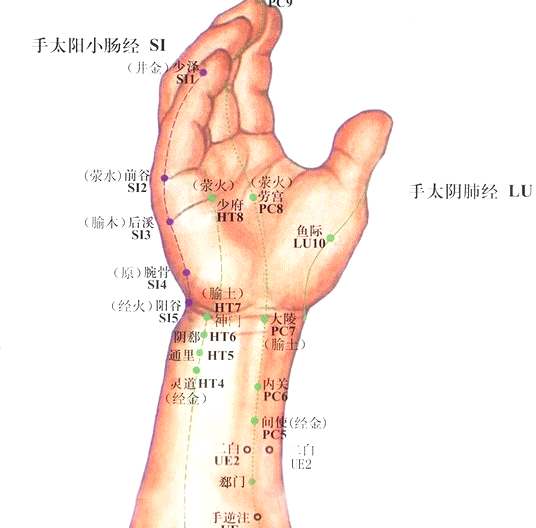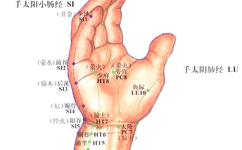The luo vessels are branches that diverge from the main meridians, serving to enhance the connection and regulation between the yin and yang of the interior and exterior. Each of the twelve meridians and the Ren and Du meridians has a separate luo vessel, totaling fifteen luo vessels.
Hand Jueyin Luo Vessel, one of the fifteen luo vessels. According to the Ling Shu: Jing Mai: “The branch of the palm, named Neiguan, is located two cun from the wrist, diverging between the two tendons, following the meridian upwards to connect with the pericardium, linking to the heart.” This means that this luo vessel branches from the Neiguan point, located two cun from the wrist, running between the two tendons, ascending along the main meridian to connect with the pericardium, dispersing and linking to the heart (the vascular tissue surrounding the heart).
If this luo vessel is affected by disease, it may cause heart pain in excess conditions, or anxiety in deficiency conditions. Neiguan point can be used for treatment.
The Hand Jueyin Luo Vessel serves to connect the Hand Jueyin meridian with its corresponding Hand Shaoyang meridian, primarily functioning to communicate between the two meridians and supplement the flow of the meridians.
[Neiguan Point]

Neiguan refers to the inner side, contrasting with the outer side, and ‘guan’ means a pass or barrier. This point is located on the inner side of the forearm, resembling a barrier, hence the name Neiguan.
Location: On the palmar side of the forearm, on the line connecting the Quze and Daling points, two cun above the wrist crease, between the tendon of the palmaris longus and the tendon of the radial flexor of the wrist.
Needling Method: Slightly flex the wrist and make a fist, measure three fingerbreadths upwards from the wrist crease, and the point is located between the two tendons.
Functions: Calms the mind, soothes the spirit, harmonizes the stomach and counteracts rebellious qi, alleviates pain.
Indications: Disorders of the cardiovascular, mental, and digestive systems, such as heart pain, palpitations, rheumatic heart disease, pericarditis, myocarditis, angina pectoris, arrhythmia, unconsciousness, postpartum fainting, epilepsy, mania, insomnia, forgetfulness, fullness in the chest and hypochondria, intercostal neuralgia, stomach pain, gastroenteritis, gastric ulcers, neurogenic vomiting, diaphragm spasm, pregnancy sickness, elbow and arm pain, hyperthyroidism, chest tightness, chest pain, vomiting, hiccups, febrile diseases, upper limb pain, hemiplegia, dizziness, migraine, palpitations, chest and hypochondriac pain, cough, shortness of breath, asthma, epilepsy, convulsions, acute fright, depression, dizziness, facial redness, red eyes, abdominal distension, diarrhea, mass in the abdomen, blood in stool, stroke, febrile diseases without sweating, deficiency labor, heat stroke, malaria, jaundice, beriberi, prolapse of the rectum, axillary swelling, elbow and wrist pain, tongue fissures with bleeding, nocturnal emissions, palpitations, mania, convulsions, elbow and arm pain, shock, arrhythmia, neurasthenia, schizophrenia, hysteria, absence of pulse, endocarditis, myocarditis, tachycardia, bradycardia, vascular occlusive vasculitis, hypertension, gastritis, gastric spasm, enteritis, dysentery, acute biliary diseases, vascular headaches, multiple neuritis, sequelae of cerebrovascular diseases, postoperative pain, hyperthyroidism, etc.
Neiguan point is commonly used for acupuncture anesthesia and pain relief.
Needling Technique: Insert straight down 0.5 to 1 cun; deeper insertion may penetrate to the Waiguan point, with local sensations of soreness and distension, or a tingling sensation radiating to the fingertips.
Moxibustion: Moxa cones for 3 to 5 cones; or moxa sticks for 5 to 10 minutes.
Massage: Use the tip of the left thumb to press the right Neiguan point for 10 to 15 minutes, 2 to 3 times daily; then use the right hand to press the left Neiguan point, repeating the process. This can improve symptoms of rheumatic heart disease, myocarditis, coronary heart disease, angina pectoris, and arrhythmia.

